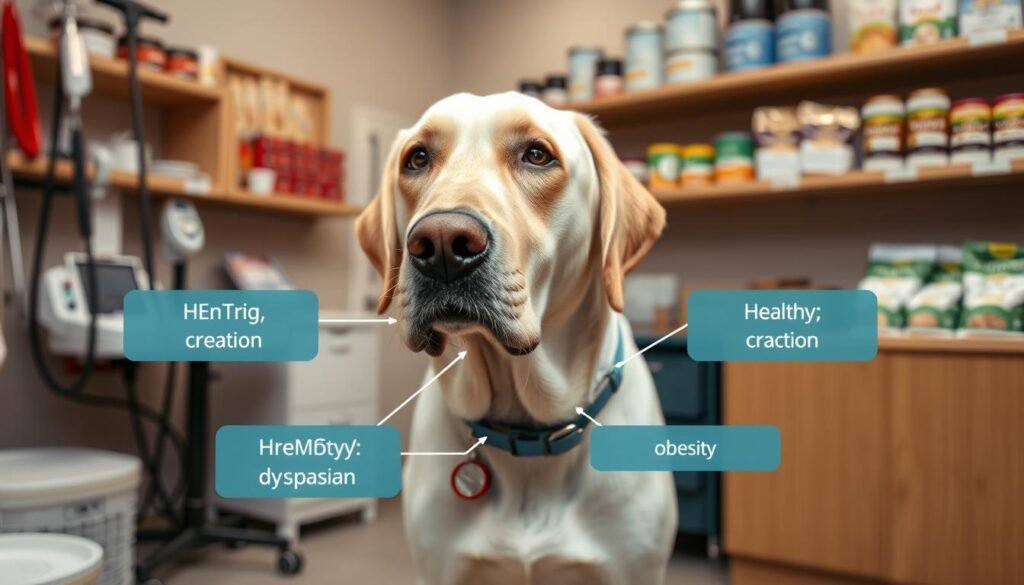Labrador Retrievers vs Rottweilers: Which Dog Is Right?
Did you know Labrador Retrievers have been America’s favorite dog for 26 years? The American Kennel Club (AKC) says this. Rottweilers are making a comeback, entering the AKC’s top 10 list after nearly 20 years.
Labrador Retrievers and Rottweilers are two unique breeds. Labs are great with families because they’re friendly. Rottweilers are excellent guard dogs due to their protective nature. Your choice depends on understanding their differences and your lifestyle.
Labs are outgoing and fit well with active families. Rottweilers are strong and smart, often chosen for their guarding skills. Think about size, energy, and care needs to pick the right dog for you.
Key Takeaways
- Labrador Retrievers have been America’s most popular breed for 26 years
- Rottweilers recently returned to the AKC’s top 10 list
- Labs are known for friendliness, while Rottweilers excel in protection
- Both breeds require proper training and socialization
- Consider lifestyle factors when choosing between these breeds
Introduction to Labrador Retrievers and Rottweilers

Labrador Retrievers and Rottweilers are popular choices for pets. They have unique origins and looks. Labradors are known for being friendly, weighing 55-80 pounds, and standing about 22 inches tall. They have short, easy-to-maintain coats in yellow, black, or chocolate.
Rottweilers are bigger and stronger. They can weigh up to 135 pounds and reach 25 inches tall. Their black and tan coats make them stand out. Both breeds are loved for different reasons. Labs are great with families and as service dogs. Rottweilers are known for their protective nature.
| Characteristic | Labrador Retriever | Rottweiler |
|---|---|---|
| Weight Range | 55-80 pounds | 77-135 pounds |
| Height | 22 inches | Up to 25 inches |
| Coat Colors | Yellow, Black, Chocolate | Black and Tan |
| Lifespan | 10-12 years | 8-10 years |
| Primary Role | Family Pet, Service Dog | Guard Dog |
Both breeds need regular exercise to stay healthy and happy. Labs fit well in many homes, but Rottweilers need more space. Knowing these differences helps you choose the right dog for your life.
Personality Traits of Labrador Retrievers
Labrador Retrievers are loved for their friendly and outgoing nature. They are one of the most popular breeds in the United States. Their warm temperament makes them great companions for families and individuals.
Temperament and Behavior
Labs are known for being gentle and patient. They are friendly to both humans and other animals. This makes them perfect pets for homes with kids or other pets.

Adaptability and Socialization
Labradors are very adaptable and easy to socialize. Their friendly nature makes them easy to get along with. Early socialization helps them grow into well-rounded adult dogs.
Energy Levels
Labs are energetic and need lots of exercise. They need about two hours of physical activity every day. This high energy level makes them great for active people or families.
| Trait | Labrador Retrievers |
|---|---|
| Popularity Rank | 1st |
| Temperament | Friendly, outgoing |
| Adaptability | Excellent |
| Daily Exercise Needs | 2 hours |
| Socialization Ease | High |
Personality Traits of Rottweilers
Rottweilers are powerful, smart dogs with a special temperament. They have a long history, dating back to ancient Roman times. They were used to drive livestock. Now, they’re one of the most popular breeds in the U.S., known for being versatile and protective.
Temperament and Behavior
The Rottweiler temperament is marked by loyalty, smarts, and calmness. They are often seen as confident and sure of themselves. They love to lean against their owners, showing their love.
While they can be gentle and loving, about 9-10% may show dominant behavior. This shows how important early socialization is.

Protective Instincts
Rottweilers are great guard dogs because of their strong protective instincts. They are naturally cautious of strangers, a trait from their days guarding money for merchants. They have a powerful bite force of 328 pounds per square inch, making them effective at keeping threats away.
This protective nature can be channeled into various roles, like police dogs, service dogs, and therapy dogs. It’s important to remember that Rottweilers make excellent guard dogs. But, they need responsible ownership and proper training to avoid aggression. With the right care, they can be both protectors and loving family pets.
Training and Obedience: Labs vs Rottweilers
Labrador Retrievers and Rottweilers are both smart breeds. They are great for dog training and obedience. Their training abilities are worth noting for anyone thinking of getting a dog.
Trainability of Labrador Retrievers
Labradors are easy to train. They are perfect for beginners. They learn basic commands like sit, stay, and shake quickly.
Being retriever dogs, Labs are great at fetching and water activities. Their friendly nature makes them easy to socialize. This is important for their early training.
Trainability of Rottweilers
Rottweilers are smart but can be stubborn. They need a firm and consistent trainer. Their history as cattle drivers shows their guarding instincts.
It’s important to socialize Rottweilers early. They can become well-behaved adults. With the right training, they can learn complex commands and excel in protection roles.
| Breed | Trainability Level | Best Suited For |
|---|---|---|
| Labrador Retriever | High | Novice owners, families |
| Rottweiler | Moderate to High | Experienced owners, protection roles |
Both breeds do well with positive training methods. Labs might learn faster, but Rottweilers can handle complex tasks with the right motivation. Choose a breed based on your experience and training goals.
Health Considerations for Both Breeds
Knowing about breed-specific health issues is key for dog owners. Both Labrador Retrievers and Rottweilers have unique health concerns. They need the right care from a vet.
Common Health Issues in Labradors
Labradors can face health problems. Hip and elbow dysplasia are common, causing pain and mobility issues. Eye issues like progressive retinal atrophy can harm their vision.
They also tend to get overweight. This is because they love to eat and might eat too much if not watched.

Common Health Issues in Rottweilers
Rottweilers have some health issues similar to Labradors, like hip dysplasia. They’re also at risk for bloat, a serious condition where the stomach fills with gas. Bone cancer is more common in Rottweilers than in other breeds.
| Breed | Common Health Issues | Lifespan | Exercise Needs |
|---|---|---|---|
| Labrador Retriever | Hip dysplasia, eye problems, obesity | 10-12 years | 2-3 miles daily |
| Rottweiler | Hip dysplasia, bloat, bone cancer | 9-10 years | 2-3 miles daily |
Regular vet visits, good food, and exercise are vital for your dog’s health. When picking a puppy, choose a reputable breeder. They should do health checks on their dogs. This can lower the chance of your dog getting sick.
Which Breed Fits Your Lifestyle?
Choosing between a Labrador Retriever and a Rottweiler depends on your lifestyle. The American Kennel Club (AKC) lists about 200 breeds, each with unique traits. Your dog should fit your family’s needs and daily routines.
Family Compatibility
Labrador Retrievers are often great for families. They are gentle and loving, making them perfect with kids. Labs are also very smart and learn quickly, making them fun for families.
Exercise and Activity Needs
Both breeds need about two hours of exercise daily. Labs are very active and enjoy outdoor games like fetch. Rottweilers also need exercise but might prefer structured activities. Your choice depends on how much time you have for their needs.
Living Environment Preferences
Your living space is key in choosing a breed. Labs can live in apartments if they get enough exercise. They shed a lot, so grooming is important. Rottweilers need more space and are best for homes with yards. They are loyal but might not be good with other pets. Think about these points to ensure your new pet is happy.

